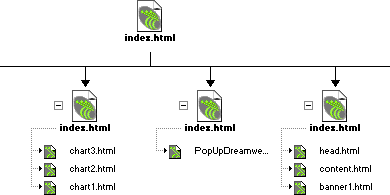Site Management and Collaboration > Using the site map
Site Management and Collaboration > Using the site map |
You must define a home page for your site before you can display the site map. The site's home page is the starting point of the map.
To define a home page for your site:
| 1 | Choose Site > Define Sites. |
| 2 | Choose New or Edit to define a new site or open an existing one. |
| The Site Definition dialog box appears. | |
| 3 | Select Site Map Layout. |
| 4 | Click the folder icon to browse for a home page for the site, or type a file path in the Home Page field. |
To view a site map, do one of the following:
| Choose Window > Site Map to open the Site window. | |
| In the Site window, click the Site Map button. |
Note: If no home page has been defined, or if Dreamweaver can't find an index.html or index.htm page in the current site to use as the home page, a dialog box appears prompting you to select a home page by clicking Define Sites. Choose the site you want, then click Edit. Then select Site Map Layout in the Site Definition dialog box.
The site map shows HTML files and other page content as icons. Links are displayed in the order in which they are encountered in the HTML source code.
Text displayed in red indicates a broken link.

|
|
Text displayed in blue and marked with a globe icon indicates a file on another site or a special link (such as an e-mail or script link).

|
|
A green check mark indicates a file checked out by you.

|
|
A red check mark indicates a file checked out by someone else.

|
|
A lock icon indicates a file that is read-only (Windows) or locked (Macintosh).

|
By default, the site map displays the site structure two levels deep, starting from the current home page. Click the plus (+) and minus (-) signs next to a page to show or hide pages linked below the second level.

By default, hidden files and dependent files are not displayed in the site map. Hidden files are HTML files marked as hidden. Dependent files are non-HTML page content such as images, templates, Shockwave files, or Flash files. See Modifying the site map layout and Showing and hiding site map files.